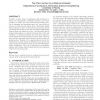Free Online Productivity Tools
i2Speak
i2Symbol
i2OCR
iTex2Img
iWeb2Print
iWeb2Shot
i2Type
iPdf2Split
iPdf2Merge
i2Bopomofo
i2Arabic
i2Style
i2Image
i2PDF
iLatex2Rtf
Sci2ools
100
click to vote
GIS
2010
ACM
2010
ACM
Evaluation of cardinal direction developments between moving points
Recently, a wide range of applications like hurricane research, fire management, navigation systems, and transportation, to name only a few, has shown increasing interest in managing and analyzing space and time-referenced objects, so-called moving objects, that continuously change their positions over time. In the same way as moving objects can change their location over time, the spatial relationships between them can change over time. An important class of spatial relationships are cardinal directions like north and southeast. In spatial databases and GIS, they characterize the relative directional position between static objects in space and are frequently used as selection and join criteria in spatial queries. Transferred to a spatiotemporal context, the simultaneous location change of different moving objects can imply a temporal evolution of their directional relationships, called development. The goal of this paper is to illustrate, explain, and formally define cardinal dir...
Automated Reasoning | Cardinal Direction | GIS 2010 | So-called Moving Objects | Spatial Relationships |
Related Content
| Added | 25 Jan 2011 |
| Updated | 25 Jan 2011 |
| Type | Journal |
| Year | 2010 |
| Where | GIS |
| Authors | Tao Chen, Hechen Liu, Markus Schneider |
Comments (0)

